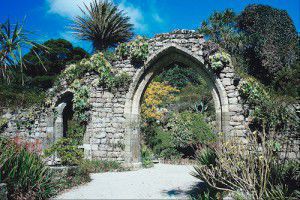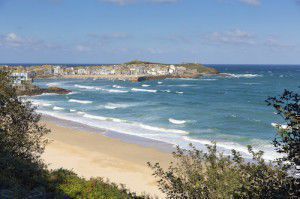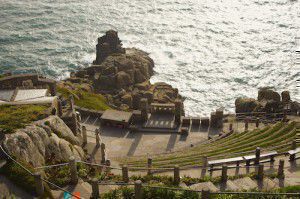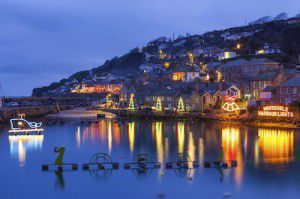10 reasons to visit… Cornwall
With St Piran’s Day approaching fast, what better time for a blog post on why to visit lovely Cornwall? Despite the occasionally severe weather and lack of phone signal, everyone who’s ever been to Cornwall seems to love it, and here (in my opinion) is why:
1. The Isles of Scilly
Situated 30-odd miles off the mainland, this archipelago boasts its own microclimate of tropical plants and pearl-white beaches. A network of ferries connect the inhabited (and some of the uninhabited) islands, making daily dashes across the turquoise waters. If you’re there for a week, it’s worth taking a new ferry trip each day, as all the islands have quite different scenery, but if you’re just on a day trip from the mainland you might want to join the crowds in the Tresco Abbey Gardens, a stunningly maintained collection of exotic plants in a vibrant setting. Don’t forget to meander down to the corner of the Gardens know as ‘Valhalla’, where you will find a graveyard of figureheads salvaged from Scilly wrecks.
2. Pasties
I just said that to get your attention: although the Cornish Pasty is definitely a wonderful creation, and a very famous Cornish export, it’s by no means the only food on offer. Try to sample some other local delicacies during your trip, such as saffron cake, clotted cream (preferably in the form of a cream tea), Yarg cheese, mead wine, local beers, hevva cake, crab sandwiches, fudge, fairings, and lots of freshly caught fish.
3. Bodmin Moor
Contrasting with the fabulous white beaches are the wild moors which inspired Daphne Du Maurier’s ‘Jamaica Inn’. Great yellow, gnarled expanses dotted with abandoned engine houses and mining debris, the moors are also home to a huge range of archaeological treasures from the Neolithic, Bronze and Iron Age. You almost can’t turn around in Cornwall without stumbling over a barrow, hill fort, stone circle, cist or coit – an archaeologist’s heaven.
4. St Ives
You can’t really visit Cornwall without visiting St Ives, and if you go to St Ives you’ll understand what it was that inspired such great artists as Barbara Hepworth, Peter Lanyon, Bernard Leach and Alfred Wallis, as well as writers like Virginia Woolf (whose famous Lighthouse lies a stone’s throw away from the town). St Ives has the perfect combination of azure sea, white sand and tiny pastel-coloured cottages crammed together along crooked lanes. Nowadays, it is home to the Tate Modern, stunningly housed in the old gasworks, as well as to numerous private galleries and the hidden gem that is Barbara Hepworth’s walled sculpture garden.
5. Festivals
Cornwall loves an excuse to celebrate, and there are plenty of local and international festivals celebrating music, food and – of course – boats. For May Day, go to Padstow for Obby Oss Day, where the town splits into two (the red and the blue) and each side dances through the street after a wooden horse (the Oss), welcoming the spring with their May song. For New Year, dress up in your finest fancy dress and spend the evening dancing through the streets in the world famous St Ives (or the slightly less famous, but no less fun, Looe). And in June spend a day or two at the Sea Shanty Festival in Falmouth, trailing from one pub to the next and hearing a different shanty group (some coming from as far away as Brittany) in each one.
6. Fishing, sailing and surfing
Whether you’re a pro or an amateur, there’s great surf to be had in Cornwall and plenty of surf schools to help you along. Sailing and fishing trips are also readily available (ever wanted to try shark fishing?) and plenty of local pubs and restaurants serve the catch of the day. Gig racing is another popular sport in Cornwall, with lost of coastal villages having their own club and the World Pilot Gig Championships taking place on the Isles of Scilly in May each year.
7. Minack theatre
Visible from the sea, the Minack amphitheatre is open from May to September each year, staging plays against the stunning backdrop of cliffs and ocean. You’ll find yourself directed to a seat carved into the cliff (bring a cushion and some rugs for warmth) from which you look down on the stage at the very edge of the cliff – walk the Coast Path around here and you’ll see the tiny, rickety cliff path the actors use when they go backstage. Although atrocious weather can lead to a play being called off, in general the natural elements add a special dramatic effect to the performance, so if you ever get a chance to see The Tempest there on a stormy night, go!
8. South West Coast Path
Whether you have a few weeks spare to complete the whole trail around the Cornish coast, or just a few hours to do one of the shorter walks, it’s worth factoring a coastal walk into your trip. The coastline changes dramatically all around Cornwall, from the barren scrub of Land’s End to the high cliffs of Bude, to the pretty fishing villages of Coverack and Cadgwith. There are plenty of campsites and inns to stay in along the way, as well as endless beaches to go for a paddle and bathe your sore feet.
9. The Mousehole Lights
Each year over Christmas and New Year, the tiny fishing village of Mousehole decks itself out in the most impressive light display. Go there of an evening and wander around the miniature streets, spying giant Christmas puddings, Loch Ness Monsters, whales, bells, candles and silhouetted ships spreading from the harbour all the way up the hill. Mulled wine and apple juice are available in the streets, and most of the art galleries and shops stay open late for last-minute Christmas shopping.
10. Feeling that you’re somewhere a little bit different
Cross the border and you’ll start to get that pleasant feeling of being in a slightly foreign land. Cornwall has a very strong sense of identity and it’s very proud of its culture, as you’ll notice from the enormous number of Cornish flags flying in place of the St George’s Cross. Although you might not be lucky enough to hear anyone speaking Cornish (speakers are still a rarity, although it’s not hard to find a Cornish language class if you want to), a little smattering of words won’t go amiss if you want to figure out some of the place names. For example, anywhere beginning ‘Tre’ (which is basically everywhere in Cornwall) is going to be a village and anywhere with ‘porth’ in it is likely to have a harbour. If you want to learn a few more Cornish phrases, get our uTalk Classic Cornish. Or you can try a few words for free on our website.
Nat





Trackbacks & Pingbacks